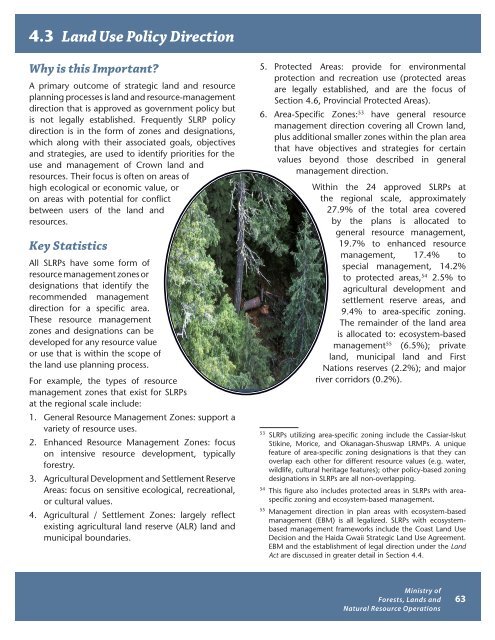Crown Land: Indicators and Statistics - Ministry of Forests
Crown Land: Indicators and Statistics - Ministry of Forests
Crown Land: Indicators and Statistics - Ministry of Forests
Create successful ePaper yourself
Turn your PDF publications into a flip-book with our unique Google optimized e-Paper software.
4.3 <strong>L<strong>and</strong></strong> Use Policy Direction<br />
Why is this Important?<br />
A primary outcome <strong>of</strong> strategic l<strong>and</strong> <strong>and</strong> resource<br />
planning processes is l<strong>and</strong> <strong>and</strong> resource-management<br />
direction that is approved as government policy but<br />
is not legally established. Frequently SLRP policy<br />
direction is in the form <strong>of</strong> zones <strong>and</strong> designations,<br />
which along with their associated goals, objectives<br />
<strong>and</strong> strategies, are used to identify priorities for the<br />
use <strong>and</strong> management <strong>of</strong> <strong>Crown</strong> l<strong>and</strong> <strong>and</strong><br />
resources. Their focus is <strong>of</strong>ten on areas <strong>of</strong><br />
high ecological or economic value, or<br />
on areas with potential for conflict<br />
between users <strong>of</strong> the l<strong>and</strong> <strong>and</strong><br />
resources.<br />
Key <strong>Statistics</strong><br />
All SLRPs have some form <strong>of</strong><br />
resource management zones or<br />
designations that identify the<br />
recommended management<br />
direction for a specific area.<br />
These resource management<br />
zones <strong>and</strong> designations can be<br />
developed for any resource value<br />
or use that is within the scope <strong>of</strong><br />
the l<strong>and</strong> use planning process.<br />
For example, the types <strong>of</strong> resource<br />
management zones that exist for SLRPs<br />
at the regional scale include:<br />
1. General Resource Management Zones: support a<br />
variety <strong>of</strong> resource uses.<br />
2. Enhanced Resource Management Zones: focus<br />
on intensive resource development, typically<br />
forestry.<br />
3. Agricultural Development <strong>and</strong> Settlement Reserve<br />
Areas: focus on sensitive ecological, recreational,<br />
or cultural values.<br />
4. Agricultural / Settlement Zones: largely reflect<br />
existing agricultural l<strong>and</strong> reserve (ALR) l<strong>and</strong> <strong>and</strong><br />
municipal boundaries.<br />
5. Protected Areas: provide for environmental<br />
protection <strong>and</strong> recreation use (protected areas<br />
are legally established, <strong>and</strong> are the focus <strong>of</strong><br />
Section 4.6, Provincial Protected Areas).<br />
6. Area-Specific Zones: 53 have general resource<br />
management direction covering all <strong>Crown</strong> l<strong>and</strong>,<br />
plus additional smaller zones within the plan area<br />
that have objectives <strong>and</strong> strategies for certain<br />
values beyond those described in general<br />
management direction.<br />
Within the 24 approved SLRPs at<br />
the regional scale, approximately<br />
27.9% <strong>of</strong> the total area covered<br />
by the plans is allocated to<br />
general resource management,<br />
19.7% to enhanced resource<br />
management, 17.4% to<br />
special management, 14.2%<br />
to protected areas, 54 2.5% to<br />
agricultural development <strong>and</strong><br />
settlement reserve areas, <strong>and</strong><br />
9.4% to area-specific zoning.<br />
The remainder <strong>of</strong> the l<strong>and</strong> area<br />
is allocated to: ecosystem-based<br />
management 55 (6.5%); private<br />
l<strong>and</strong>, municipal l<strong>and</strong> <strong>and</strong> First<br />
Nations reserves (2.2%); <strong>and</strong> major<br />
river corridors (0.2%).<br />
53 SLRPs utilizing area-specific zoning include the Cassiar-Iskut<br />
Stikine, Morice, <strong>and</strong> Okanagan-Shuswap LRMPs. A unique<br />
feature <strong>of</strong> area-specific zoning designations is that they can<br />
overlap each other for different resource values (e.g. water,<br />
wildlife, cultural heritage features); other policy-based zoning<br />
designations in SLRPs are all non-overlapping.<br />
54 This figure also includes protected areas in SLRPs with areaspecific<br />
zoning <strong>and</strong> ecosystem-based management.<br />
55 Management direction in plan areas with ecosystem-based<br />
management (EBM) is all legalized. SLRPs with ecosystembased<br />
management frameworks include the Coast <strong>L<strong>and</strong></strong> Use<br />
Decision <strong>and</strong> the Haida Gwaii Strategic <strong>L<strong>and</strong></strong> Use Agreement.<br />
EBM <strong>and</strong> the establishment <strong>of</strong> legal direction under the <strong>L<strong>and</strong></strong><br />
Act are discussed in greater detail in Section 4.4.<br />
<strong>Ministry</strong> <strong>of</strong><br />
<strong>Forests</strong>, <strong>L<strong>and</strong></strong>s <strong>and</strong><br />
Natural Resource Operations<br />
63

















